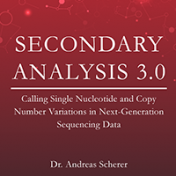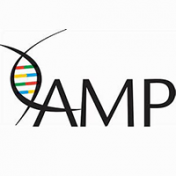We have released a new version of my eBook, “Secondary Analysis 3.0”. To download a complimentary copy, I encourage you to do so here. Next-Generation Sequencing (NGS) promises to be the ultimate paradigm when it comes to genetic research and clinical testing since it contains the complete genetic information. When it comes to the current reality in testing labs, there… Read more »
Happy New Year. I trust you had a relaxing time over the holidays with family and friends as well as a great start into 2019. Golden Helix certainly had a landmark year. There were many highlights that actually shaped the direction for us in the years to come. Please let me mention a few: We launched VSClinical in May 2018:… Read more »
We are happy to announce that our latest version of SVS includes the ability to call CNVs on low read depth Whole Genome Sequencing (WGS) data. Designed for calling large cytogenetic events, this algorithm can detect chromosomal aneuploidy events and other large events spanning one or more bands of a chromosome from genomes with average coverage as low as 0.05x…. Read more »
We are honored to announce that we have been named one of the Top 10 Biotechnology Solution Providers for the second year in a row by CIO Applications. We are at a point where precision medicine is taking off.The Centers for Medicare & Medicaid Services (CMS) has started to reimburse testing labs for NGS-based tests. This is a game changer… Read more »
The PhoRank tool in VarSeq is further explored in this post by looking at the sample-specific capability. VarSeq PhoRank Part: 1 Variant Phorank Gene Ranking showed how the PhoRank algorithm could be applied to all the variants in a VarSeq project, regardless of the number of (or difference in) samples. There is another PhoRank algorithm in VarSeq that allows the… Read more »
One of the main goals of clinical genomic labs is to identify problematic variants in affected individuals. One tool to assist in this search is the phenotype driven variant ontological re-ranking tool in VarSeq called PhoRank. A common situation facing clinicians is sorting through thousands of variants provided by an individual’s exome data (or possibly the individual’s nuclear family exome… Read more »
What is Genomic Prediction? Genomic prediction is an algorithm widely used to improve desirable phenotypic traits in agriculture. For example, the cattle industry uses genomic prediction to improve beef quality and palatability as well as improve dairy production (1,2). By using genomic prediction, researchers can minimize multiple expenses in breeding industries as well as diminish the need for performing cumbersome… Read more »
High product quality is a foundational characteristic of a useful and successful product. Quality testing, therefore, is a necessary, albeit an open-ended task. It can at times seem a limitless undertaking in the present using experience from the past to improve the future. Nonetheless, it is approached as a development stage at Golden Helix that is just as essential as… Read more »
In a recent webcast, our VP of Product and Engineering Gabe Rudy gave us insight into the current capability and benefits to lifting over to the GRCh38 assembly. Golden Helix fully supports this transition into the most recent reference assembly and have developed our tools on both the 38 and 37 fronts. The purpose of this blog is to not… Read more »
The SVS 8.8.3 release was created to incorporate some of the CNV, genome assembly control, and splice site capabilities that are present in VarSeq, as well as clean up and streamline the GWAS workflows (like when using Mixed Linear Model algorithms) for a better user experience. New Product Add-Ons for SVS GoldenHelix SVS now includes in-silico splice site, functional prediction… Read more »
This blog will conclude our VSClinical Best Practice Workflow series and focuses on one of our new reports: VSClinical ACMG Gene Panel Template. This template is valuable because it automatically enters your variant interpretation from the ACMG Guidelines into the report and eliminates the need for manual submission. I would like to explain how to properly implement this report into… Read more »
In part one of this series, we discussed how the ACMG Classifier can be implemented in your filter chain to support a best practice workflow. To continue our discussion on best practices of VSClinical, this blog will shed light on other attributes of VSClinical that can add support to your evaluation. Specifically, we will explore how VSClinical can help users… Read more »
VSClinical is our most recent product that allows users to evaluate variants according to the ACMG guidelines. As with any tertiary analysis, there is a need to implement best practices into your workflow and using VSClinical for the ACMG guidelines is no exception. That said, we have put together a Best Practices Blog Series, with the purpose of discussing some… Read more »
This webcast generated a lot of great questions about the content covered in the video above. I have summarized our Q&A session below and included some questions I didn’t have time to answer during the live event. If you have any further questions, reach out to us at info@goldenhelix.com! Q: Can I upload my existing classifications into a consortium source?… Read more »
We just got back from three busy days at the Molecular Pathology (AMP) conference in friendly San Antonio, Texas. Keeping up the Golden Helix conference momentum for the year, we had 3-4 in-booth demonstrations a day covering our CNV calling, variant interpretation, and data warehousing products for NGS-based genetic tests. And in short, NGS based tests for cancer and germline… Read more »
VarSeq Stable 2.1.0 is Ready for Clinical Validation, See it in Action Next Week This week we are happy to see the general availability of VarSeq 2.1, the culmination of the last five months of work since we launched VSClinical. We have been blown away by the adoption of VSClinical, outpacing any previous product launch in terms of the pace… Read more »
We’ve packed our bags and we’re off to The Lone Star State to take part in the Association for Molecular Pathology Annual Meeting and Expo (AMP 2018)! As first-time attendees, we’re looking forward to integrating ourselves in the AMP community and showcasing our clinical stack, including VSClinical released earlier this year. Come on over and introduce yourself, you’ll find us… Read more »
We love when our viewers send questions in during the webcast but unfortunately we can’t answer all of them during the time allotted! If you asked a question see below for answers, or if after viewing, you have any questions that weren’t asked, please feel free to send those over to support@goldenhelix.com. Does this work for FFPE derived DNA or ctDNA?… Read more »
Following a wonderful September with our 20th Anniversary and being awarded an NIH-SBIR Phase 2 Grant, October has been nothing short of exciting for us here at Golden Helix. We know that none of our success could happen without the continuous support all of you show us – so thank you to everyone who is a part of this awesome… Read more »
In the first two parts of this blog, we presented examples of how to leverage Warehouse-stored VSClinical and CNV assessment catalogs in the VarSeq project. Now we are going to explore the Warehouse interface a bit more and show how to query on stored variant data. To access Warehouse from VarSeq, click the V Connect icon located in the top… Read more »














